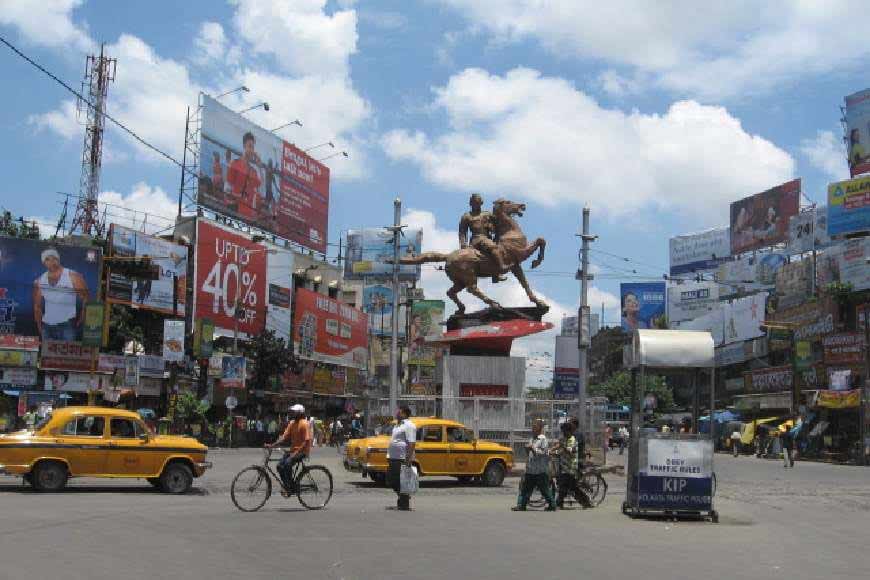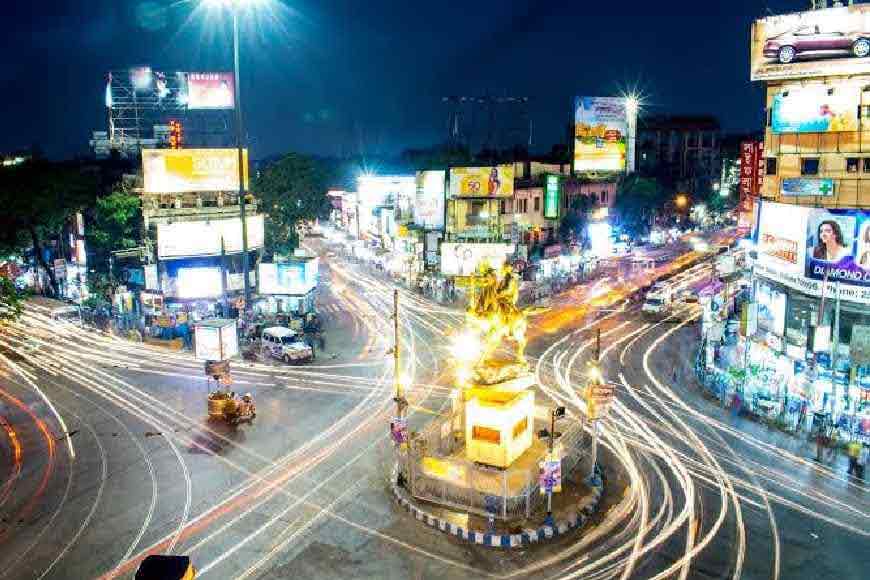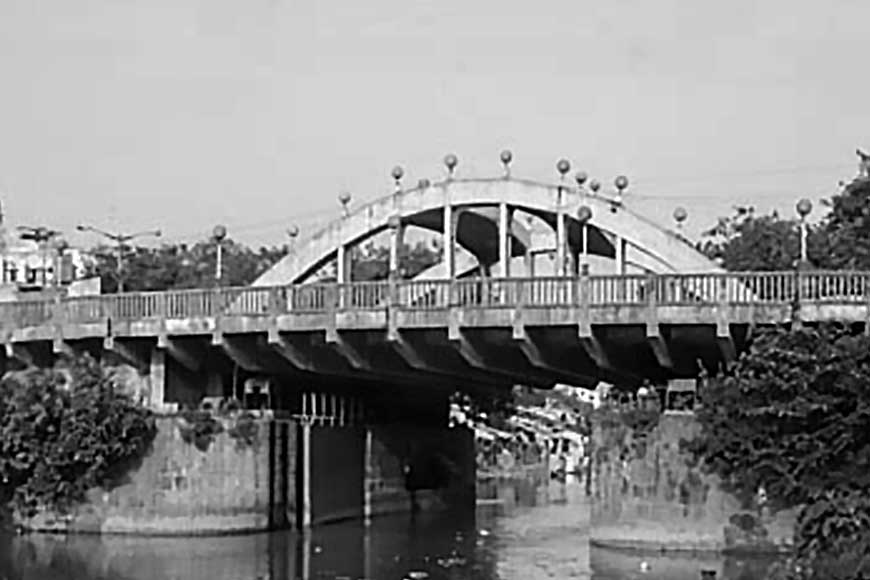Shyam Bazar: What’s in a name?

Since childhood, most Bengali children are taught the pronunciation of the Bengali alphabet ‘Sh” by referring to a limerick that goes like this: ‘Syam Bajarer Sossi Babu/ Sombar sokaale,/Sorsoriye cycle chepe/ Salir sathe sosa khete khete/ Sosorire swarge jaan’. Throughout the poem, the alphabet Sh is erroneously articulated and as it transpires, Shashi Babu from Shyambazar is excellent on his bicycle but has difficulty pronouncing S. Shyambazar in north Kolkata is an important locality and an intersection of five major roads (Panch Mathar More aka Five-point crossing). This area has a long and chequered history.
In the 18th century, before Kolkata came into being, Sutanuti, Gobindopur, and Kolkata were three neighboring villages on the banks of the Hooghly River. In 1658, when Kashimbazar became the hub of business, a yarn market existed in Kolkata called “Sutanuti,”— suta- meaning yarn, and nuti meaning bundle. This is where the weaver’s community lived and where the traditional yarn market existed. Yarn dealers lived mainly in the port of Saptagram and when the Saraswati river which flowed beside it started drying, the port became dysfunctional and the weavers migrated to Sutanuti.
The Basaks and the Setts were amongst the first to have settled in Sutanuti, after having cleared the jungles. Sobharam Bysack was one of the wealthiest native inhabitants of 18th century Kolkata. Sovaram owned a huge plot in Sutanuti, where he had a textile workshop. The land where presently Sovabazar Raj Bari exists also belonged to him. It was a marshy land then, where villagers cultivated vegetables. With time, it became a marketplace (Bazar) where cultivated vegetables, textiles, and clothes were traded. The Bazar and the locality came to be known as Sovabazar. Sovaram used to control the prices of clothes and vegetables in this Bazar. Later, Sovaram’s grandson, Govindchand Bysack, handed over the land to Naba Krishna Deb of Sovabazar Rajbari, and the Bazar shifted to Chitpur Road.

The origin of the name Shyam Bazar is shrouded in mystery and controversies. The most well-known claim is obviously made by the house of the Bysacks. it was named after Sovaram’s house deity, Shyam Rai Jeu (Govinda). As per a correspondence in the ‘Indian Daily News’ dated 24th Oct’1887, Sir John Zephaniah Holwell had changed the name of Shyam Bazar to Charles Bazar. However, Sovaram requested him to revert to the earlier name, i.e., Shyam Bazar, and Holwell complied. The name was again changed back to Shyam Bazar and the water body beside it was named Shyampukur. Although the water body no longer exists today, both Shyambazar locality and Shyampukur Lane exist as a testimony of the olden times.
Also read : Go see a Kolkata ‘mess bari’ before it vanishes
Some believe a Brahmin named Shyamacharan Mukhopadhyay resided in the vicinity of Sutanuti. His house was close to a pond that was later named Shyampukur and the area came to be known as Shyam Bazar. The name Shyam Bazar featured in the first official map of Kolkata made in 1784 by Lt. Col Mark Wood and supports the fact. However, GourdasBasakinsisted that Shyam Bazar derived its name from wealthy zamindar Sovaram’s household deity, Shyam Rai Jeu (Govinda). But who was GourdasBasak? This talented and erudite gentleman hailed from the rich businessman family of the Bysacks and was born in 19th-century Calcutta. He was a Deputy Magistrate under the British government but he did a considerable amount of research on ancient India’s archaeological findings which were published in the Asiatic Society’s journals. He was also elected the president of the Asiatic Society. He was a close aide of Pundit Ishwar Chandra Vidyasagar and participated in social reforms. He was also a very close friend of poet Michael Madhusudan Dutta who helped him with funds when the poet was going through an acute financial crisis. There is a lane named after Basak in Shyambazar.
There is a third and very interesting albeit lesser-known fact about the origin of the name, Shyam Bazar. Shyam Bazar was once a market for sea salts. In old Bengali, sea salt used to be referred to as 'Shyam'. Many entrepreneurs including Prince Dwarakanath Tagore, grandfather of Rabindranath, made their fortune by trading salt at that time. Even Antony “Firingi” (Hensman Anthony, a trader of Portuguese origin) was a salt merchant. Dwarkanath started his career as a 'Nimki Dewan' or 'Salt Superintendent' of the East India Co. His first posting was in Basirhat'sBagunda. Incidentally, 'Basir' also means 'salt'. So Basirhat was a salt market and Shyam Bazar and Basirhat held the key to Bengal's salt trade.
The salt storehouses were mainly situated towards Belgachhia which have turned into ruins today but the storehouses by the banks of the river near Burrabazar are still functional. Not far from Shyambazar, in Baranagar, there was a factory for pork meat processing, wrote East India Company employee, Strensam Master in 1676. This meat was exported to foreign countries. It may be so that the salt needed in the processing was supplied from the Shyam Bazar warehouses.
 Maratha Ditch
Maratha Ditch
In 1742, a three-mile-long Maratha Ditch was excavated as a protection against the marauding Maratha soldiers then foraging in the countryside but who never came. It was filled up in 1799 to build the Circular Road, which ran from Shyambazar, right around old Kolkata, covering the southern end of the Maidan. The growth and development of the neighbourhood and surrounding localities largely followed the construction of roads that opened up the area. Sutanuti had no roads, except the pilgrim path extending across it from Halisahar to Barisha. Chitpur Road (renamed Rabindra Sarani) was developed along this path. It passed through neighbouring Bagbazar and Chitpur. Road construction picked up in the early 19th century. The Lottery Commission (1817) and its successor the Lottery Committee (1836)opened up the native parts of old Kolkata. The main axial thrusts were from south to north, parallel to the existing Chowringhee-Chitpur alignment. Modern Shyambazar was metalled in the early 19th century. Around the same time, the most important axial thoroughfare from south to north was around Wood Street, Wellesley Street, Wellington Street, College Street, and Cornwallis Street which were built by the Lottery Committee. The new road to Barrackpur and R.G. Kar Road also converged at the same point. Subsequently, the extension of Central Avenue (the Shyambazar end is now called Bhupen Bose Avenue), which was built by the Kolkata Improvement Trust formed in 1911, also converged on the same point, making Shyambazar five-point crossing one of the busiest street crossings in Kolkata.
Horse-drawn tram cars were introduced up to Shyambazar in 1882 and 1899, Calcutta Tramways Company Limited introduced electric traction. In 1902 the entire system was electrified. Subsequently, tramways were extended to Belgachia. In 1941, tram tracks were laid along Circular Road. For many years tram cars were the only form of mass transport in Kolkata. Although the first motor car appeared in Kolkata in1896, motor bus services started only in 1920. Shyambazar tram depot (now defunct) is on Bidhan Sarani, near the five-point crossing. Circular Road had a garbage clearance light railway till the early 1950s that the contemporary generation is not even aware of.
Shyambazar has traditionally been an entertainment neighbourhood. Nabin Chandra Basu staged the first Bengali production "Bidyasundar" at his Shyambazar home theatre in 1835. Later in the 19th century, crucial roles were played by Bagbazar Amateur Theatre and Shyambazar Natya Samaj, in highlighting the demand for public commercial theatres open to the public, as opposed to private home theatres of the rich. Star Theatre has always been the focal point of attention in Shyambazar and is synonymous with thespian Noti Binodini, Girish Ghosh, and Ramakrishna Paramahansa, the great saint of Bengal. It was famous for over 100 years and during that period nearly 300 plays have been staged by different producers. More than 12 Hindi dramas were also staged at the Theatre. Unfortunately, a fire destroyed the glorious Star Theatre on 16 October 1991. It was rebuilt but it has failed to regain its old glory. Now, cinema shows are held in the auditorium.
Shyam Bazar was also the entertainment hub of Bengalis. During its heydays, cinema buffs thronged the locality that boasted of five cinema halls; Radha, Rupbani, Minar, Mitra, and Darpana in a row along Bidhan Sarani, Shyambazar was called cinema neighbourhood. The Bengali films that they screened were particularly popular with the housewives, who used to crowd the afternoon shows. Talkie Show House in Phariapikur was an outlet mostly for English films. With the advent of multiplexes, both theatre and cinema have been badly hit. However, Shyam Bazar continues to enthrall visitors and the residents of this laid-back neighbourhood enjoy the aristocracy that money cannot buy. It ripens with time.
(Ref: Wikipedia, iYouthMag Blog, inscript.me)











